Blessed with its warm climate and abundant sunshine, Southern California is truly a gardener’s paradise. This region’s beautiful weather provides the perfect setting for a wide array of stunning and gorgeous flowers to bloom throughout the year. This article will introduce you to some of the best flowers to plant in Southern California. Get ready to transform your garden into a splendid showcase of Southern California’s floral beauty!
1. Common Foxglove (Digitalis purpurea)

The common foxglove is one of the best flowers to plant in Southern California.
©iStock.com/Elmar Langle
In Southern California, the common foxglove is a well-known biennial or short-lived perennial that showcases tall, one-sided spikes of drooping, tubular, bright pinkish-purple flowers measuring 2-3 inches.
These blooms make their appearance from early to mid-summer, emerging from a base cluster of fuzzy, dark green foliage. They’re particularly appealing to hummingbirds that hover close to the tubular blooms and to other birds that gather around the seed heads in the fall.
The common foxglove thrives in areas with full sun to partial shade, preferring medium-moisture, well-drained soils. A soil rich in organic matter and situated in partial shade is ideal, but the plant can also grow in full sun. Furthermore, it has the added benefit of being resistant to deer and rabbits.
Foxgloves should be planted directly into your garden in the late spring months.
2. Coulter’s Snapdragon (Sairocarpus coulterianus)
The Coulter’s snapdragon, a variety of New World snapdragon, is native to the southern regions of California and Baja California. It’s often found thriving in desert shrublands, coastal hills, and mountainous areas, particularly in spots that have been recently affected by wildfires.
Characterized by its slender, wand-like clusters of bilaterally symmetrical flowers on stems with sparse leaves, this plant is unique. The delicate tendrils in its flower clusters can cling to nearby vegetation. The flowers bloom in a range of colors, from white to purple, and typically bloom from April through July.
The Coulter’s snapdragon can adapt to various light conditions, from full sun to full shade. It has a very low moisture requirement, making it perfect for drought-prone areas.
Generally, the seeds of snapdragons are sown around January or February, with flowering expected around June.
3. Winter Jasmine (Jasminum nudiflorum)
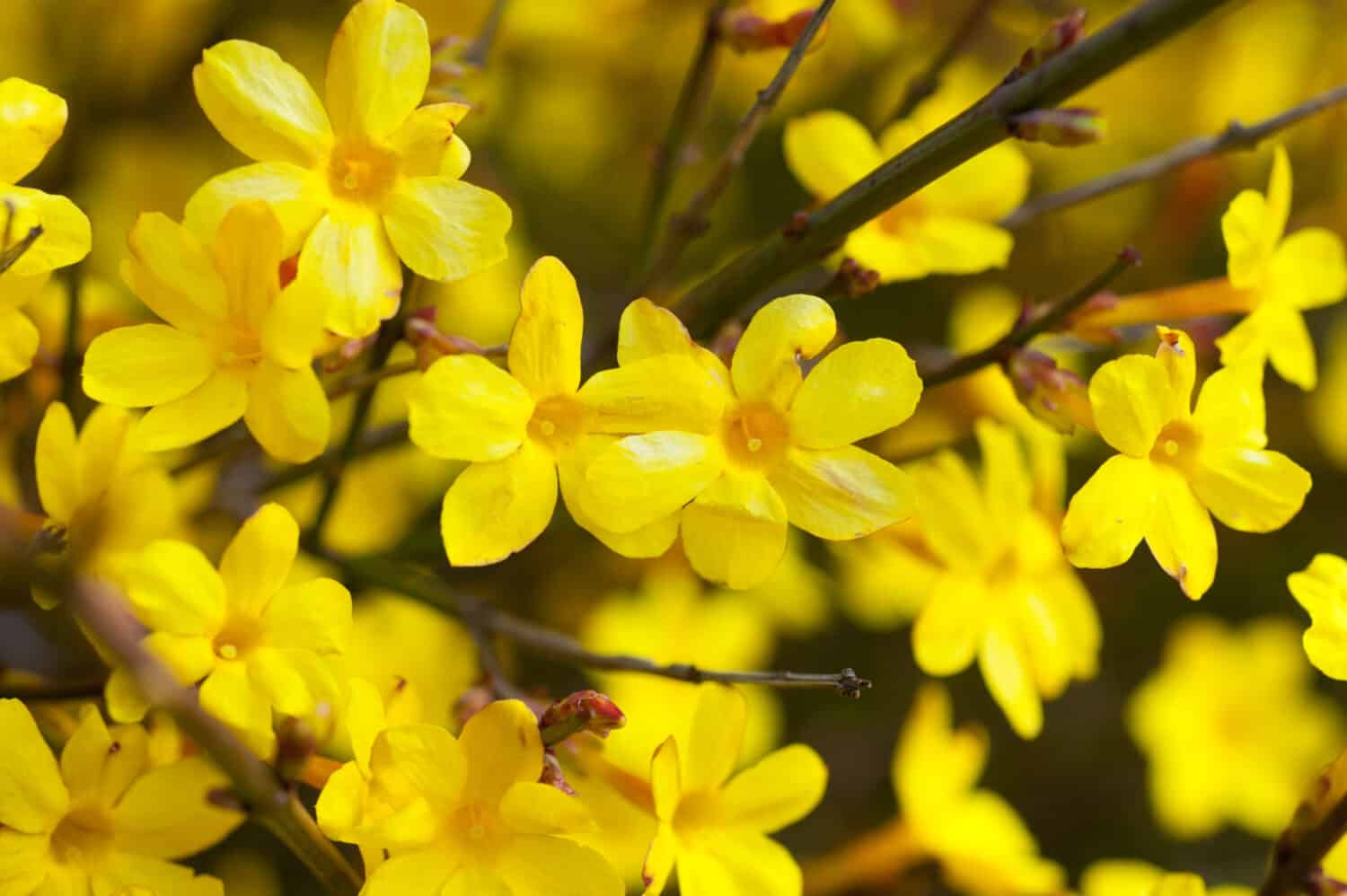
Looking for flowers that bloom in the winter? Plant winter jasmine!
©freya-photographer/Shutterstock.com
The winter jasmine, recognized for its exceptional winter bloom, is a mid-sized deciduous shrub featuring long, curving branches. Its slim, willowy green stems become noticeable in the late winter or early spring when they are covered with clusters of radiant yellow flowers measuring about an inch wide.
The winter jasmine showcases its stunning blooms during mid-winter or early spring, as its name suggests. These attractive, leaf-shedding shrubs not only draw in butterflies but are also safe for pets. In addition, they’re easy to care for.
This plant thrives in full sun to partial shade, preferring sandy loam soils that receive regular moisture. It can tolerate full shade, but to achieve the best flowering, a sunny or partly sunny location is ideal.
For the winter jasmine to display its blooms in the winter season, it’s recommended to plant them in the spring.
4. California Goldfields (Lasthenia californica)
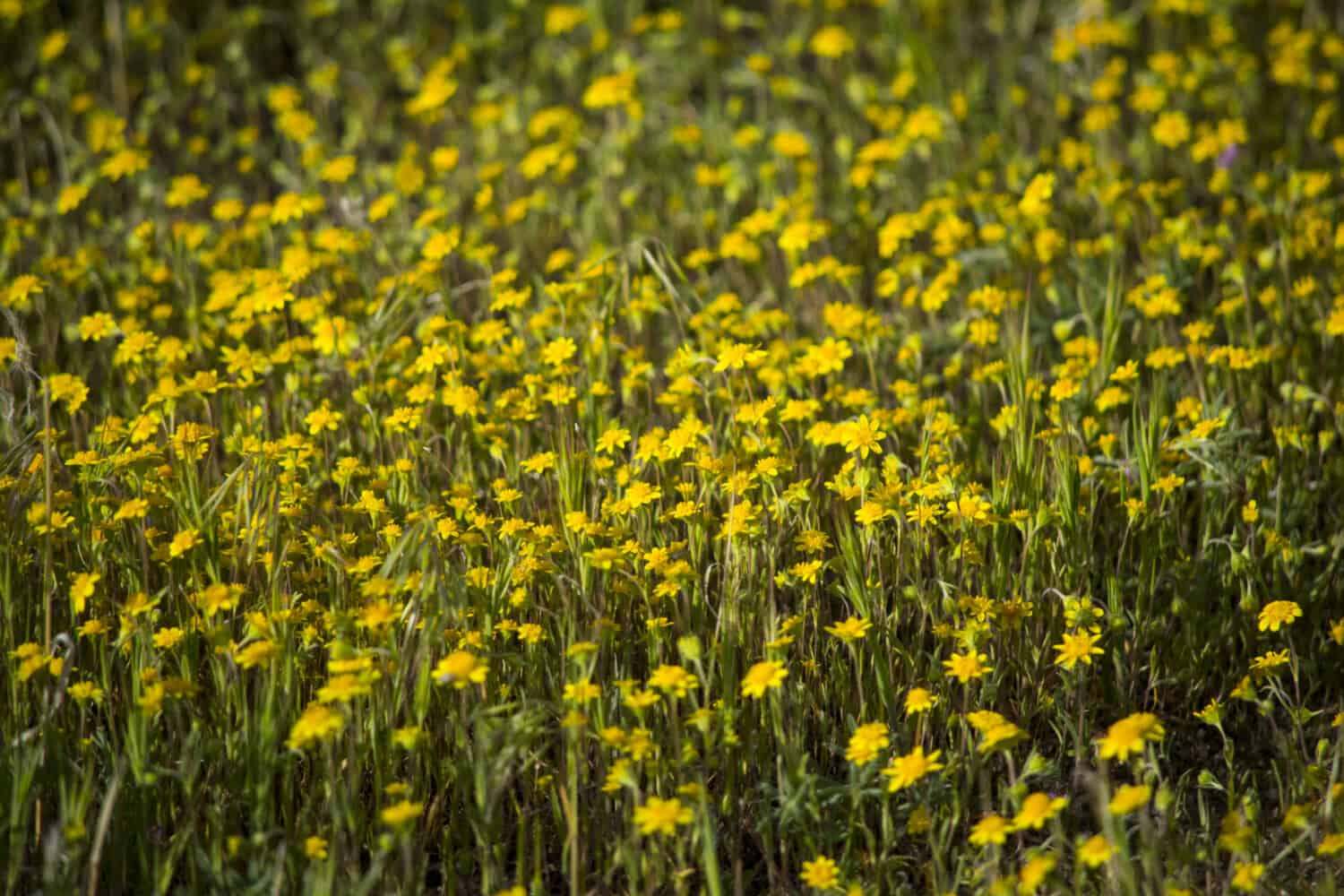
California goldfields make for great ground cover.
©Passenger Window/Shutterstock.com
Originally from the southwestern regions of the United States, California goldfields are low-lying annuals that flaunt numerous tiny, vivid yellow daisy-like blooms throughout the entire spring season. These flowers are a magnet for various pollinators, such as bees and butterflies.
In spring, California goldfields simultaneously bloom, creating an impressive golden blanket across hills and meadows, thus earning their common name. When planted in large quantities, they offer a fantastic ground cover. They’re also a beautiful addition to any wildflower garden.
This plant thrives in full sun to partial shade and can adapt to various soil types, from sandy loams to silty clay loams. It’s also drought-tolerant, making it a perfect fit for arid regions.
To experience an early burst of golden color as soon as February, spread the seeds of California goldfields outside in the late fall.
5. Yerba Mansa (Anemopsis californica)
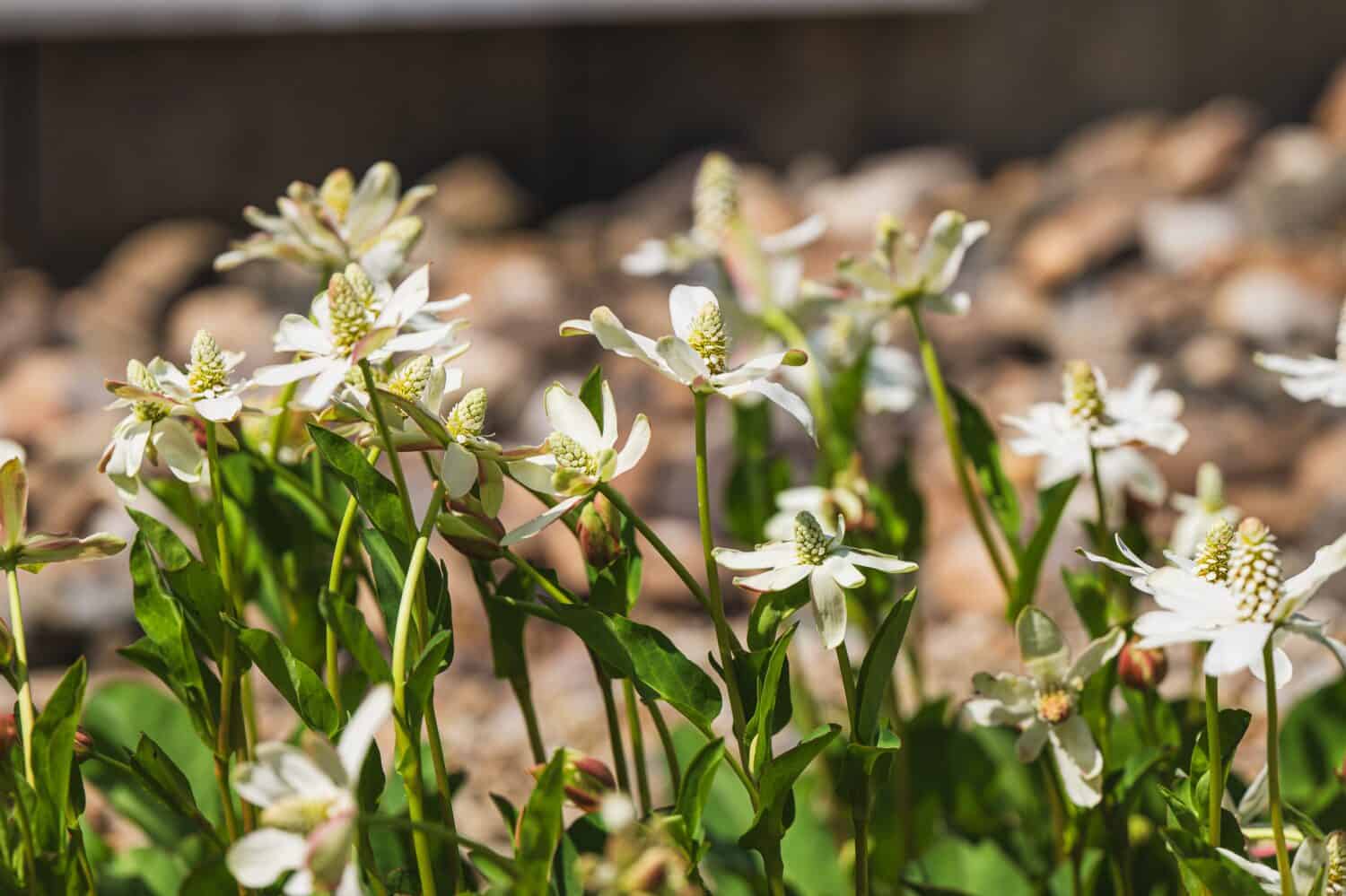
The perennial, yerba mansa boasts small white flowers.
©Rudolf_Prchlik/Shutterstock.com
The yerba mansa is a fast-spreading, low-lying perennial that displays upright flower spikes in late spring and summer in Southern California. Each spike, which barely rises above the leaves, is adorned with small, aromatic, white flowers gathered into a cone. At the base of each spike, you’ll find 4-9 large white spoon-shaped bracts that resemble petals.
This plant is known for its ability to spread like a carpet across moist soils, effectively suppressing the growth of other plants. It withers away in the fall, only to sprout fresh new foliage when spring arrives once again.
The yerba mansa flourishes in full sun or partial shade. It can endure up to 6 inches of water above its crown. Plant this flower in the spring or after the final frost has passed.
6. Sea Thrift (Armeria maritima)

Boasting pink, lavender, or white flowers, the sea thrift is easy to grow in Southern California.
©Oakland Images/Shutterstock.com
The sea thrift is a compact, year-round perennial that showcases spherical clusters of pink to lavender flowers or occasionally white ones. These blooms sit atop thin stems that rise significantly above the foliage. While they bloom profusely from mid to late spring, additional sporadic blooming might occur throughout the summer.
This little plant is incredibly simple to grow, making it an ideal choice for edging walkways or borders. Its flowers also serve well as cut flowers.
Sea thrift thrives in full sunlight and in soils that are not too rich, dry, and have good drainage. It can tolerate partial shade as well. In soils that are too rich, the leaves tend to droop outward, creating an open center. Once established, the plant is drought-tolerant. To grow sea thrift, sow its seeds in spring or fall.
7. Narrowleaf Milkweed (Asclepias fascicularis)
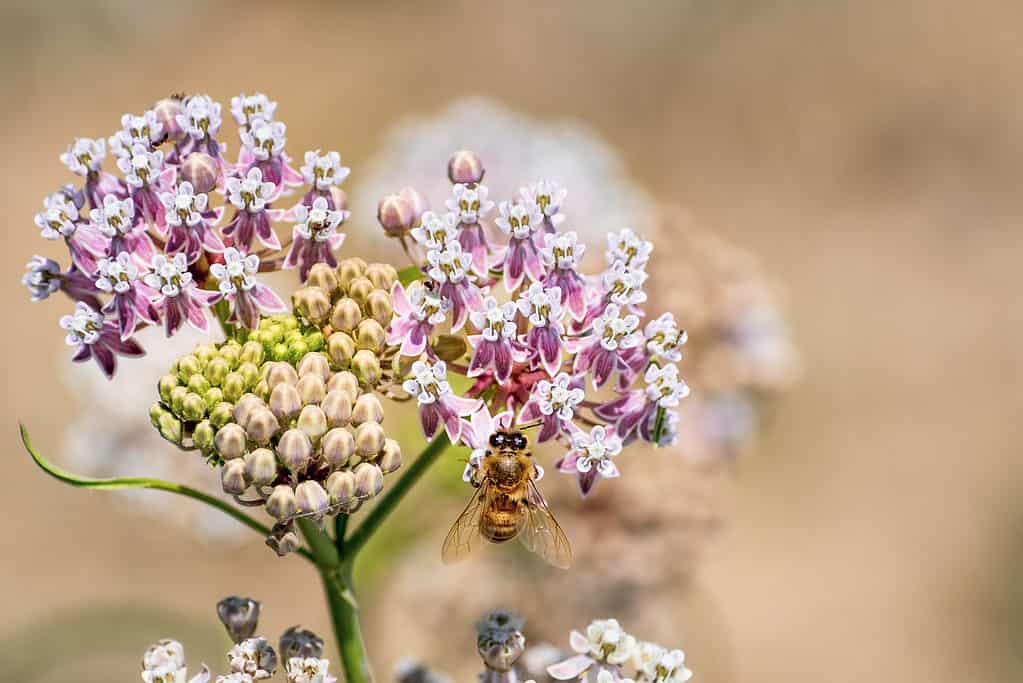
A rich source of nectar for pollinators, narrowleaf milkweed is a gorgeous perennial.
©iStock.com/Sundry Photography
The narrowleaf milkweed flower is an excellent choice among milkweed varieties to plant in Southern California! It’s a flowering perennial that presents appealing clusters of lavender and white star-shaped flowers, 4 to 5 inches across, from early summer to fall.
These flowers provide a rich nectar source for bees, hummingbirds, butterflies, and other beneficial insects. The flowers stand on slim upright stems decorated with narrow, long, pointed leaves. Keep in mind that like all other milkweed varieties, this plant is toxic to horses, cats, and dogs.
Narrowleaf milkweed thrives in full sunlight and prefers medium to dry, well-drained soils.
The ideal time to plant narrowleaf milkweed seedlings is during the rainy season. However, late winter or early spring months, such as February, March, or April, are most optimal.
8. African Marigold (Tagetes erecta)

The African marigold thrives in full sun.
©FunFamilyRu/Shutterstock.com
Renowned for its big blooms, the African marigold is a bushy annual that features enormous double flowers. The flowers, which are up to 2 to 4 inches across, come in shades of orange, yellow, and white.
From early summer till the arrival of frost, these eye-catching flowers bloom atop the foliage of pinnate leaves, divided into lance-shaped leaflets. Both the flowers and the leaves emit a pleasant aroma when crushed or brushed against.
The African marigold thrives in full sun and moderately fertile, dry to moist, well-drained soils. In regions with hot summers, it can tolerate some light afternoon shade. Interestingly, once the African marigold is established, it becomes drought-resistant. Taller varieties should be planted in areas protected from strong winds.
It’s best to plant African marigolds in the spring once the threat of frost is over.
9. Elegant Cluster-Lily (Brodiaea elegans)

A low-maintenance plant, the elegant cluster-lily is native to California.
©Sundry Photography/Shutterstock.com
The elegant cluster-lily is a low-maintenance perennial flower that thrives in Southern California. It boasts bunches of funnel-shaped blossoms in shades of violet or blue-violet from late spring all the way to mid-summer.
This plant originates in the mountainous regions of California and Oregon, favoring the environment of dry to moist meadows and open woods.
Elegant cluster-lily thrives when grown in well-drained, clay-like soils that are dry to moist. It prefers the presence of full sunlight or partially shaded areas. For areas that experience cold winters, a protective layer of mulch is recommended. To ensure this flower flourishes, it’s important to provide consistent soil moisture during its growing season.
The ideal time to plant it is during the fall or early spring.
10. Cobwebby Thistle (Cirsium occidentale)

Native to the state, the cobwebby thistle is one of the best flowers to plant in Southern California.
©Michael Vi/Shutterstock.com
The cobwebby thistle is a biennial or short-lived perennial herb native to various parts of California. It’s a plant with upright stems that can reach a height of 5 feet. This unique thistle is adorned with short, soft, matted, white hairs and flaunts strikingly bright red flowers during the summer months from May through July. It is particularly attractive to hummingbirds and adult swallowtail butterflies.
In terms of sunlight, it requires full exposure but can also tolerate partial shade. It can tolerate dry, light watering and does well in clay or loam soils.
Sowing of cobwebby thistle should be done directly outdoors from early spring. A spot with full to partial sunlight and rich, extremely well-draining soil is ideal for its growth.
11. Winecup Clarkia (Clarkia purpurea)
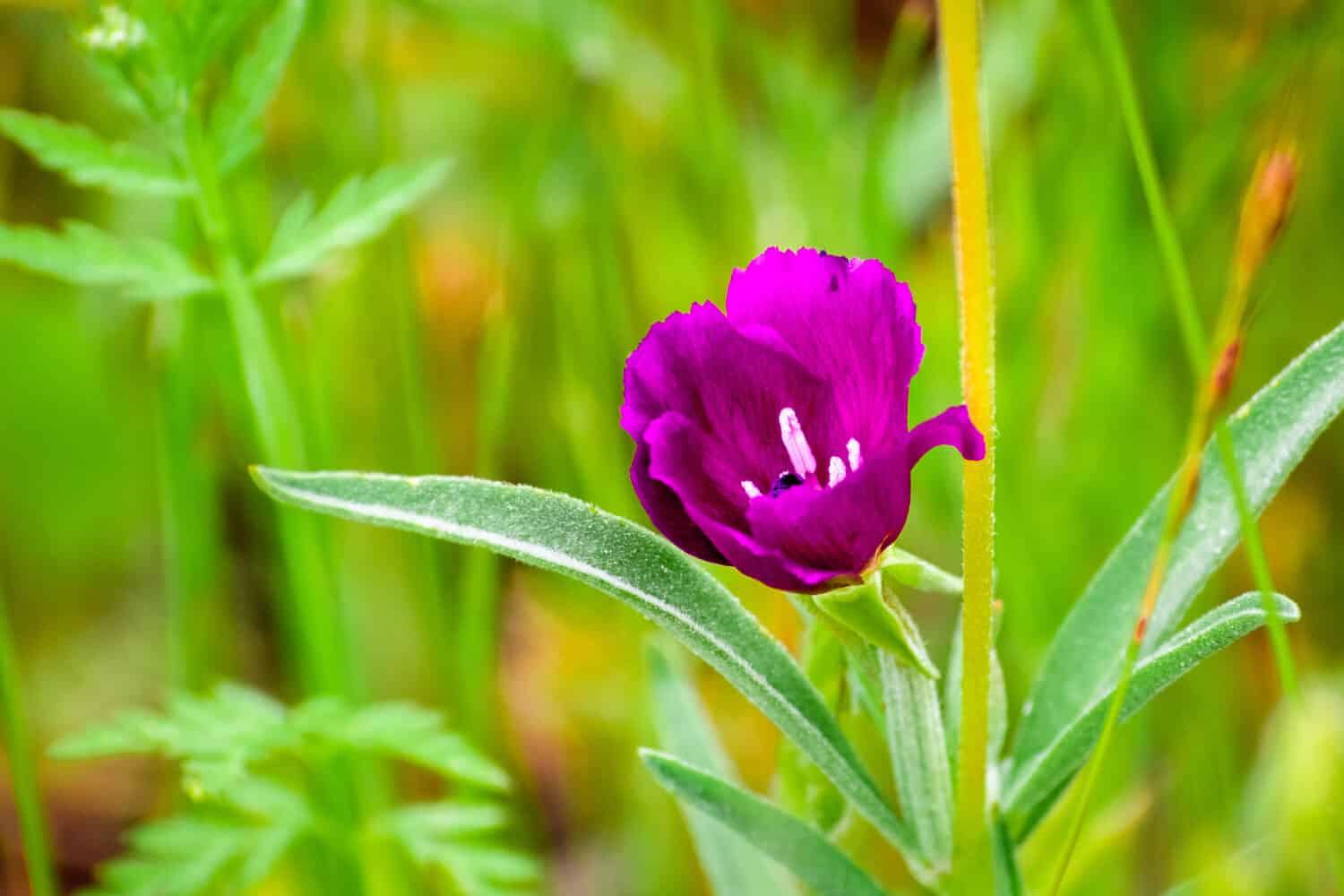
Plant the winecup clarkia after the first frost.
©Sundry Photography/Shutterstock.com
The winecup clarkia, a native flower of western North America, including California, is a striking annual wildflower that displays beautiful bowl-shaped flowers from mid-spring to mid-summer. Each flower consists of four petals that come in hues of pink, purple, or a deep wine red, typically with a central spot of pink or red. These flowers open during the day and close at night.
This flower grows best in full sunlight and can thrive in a variety of well-drained soils. It requires sufficient moisture during the winter or spring until its blooming period ends. It’s also capable of tolerating drought conditions.
It’s best to plant winecup clarkia seeds just after the last frost of spring.
12. Western Springbeauty (Claytonia lanceolata)
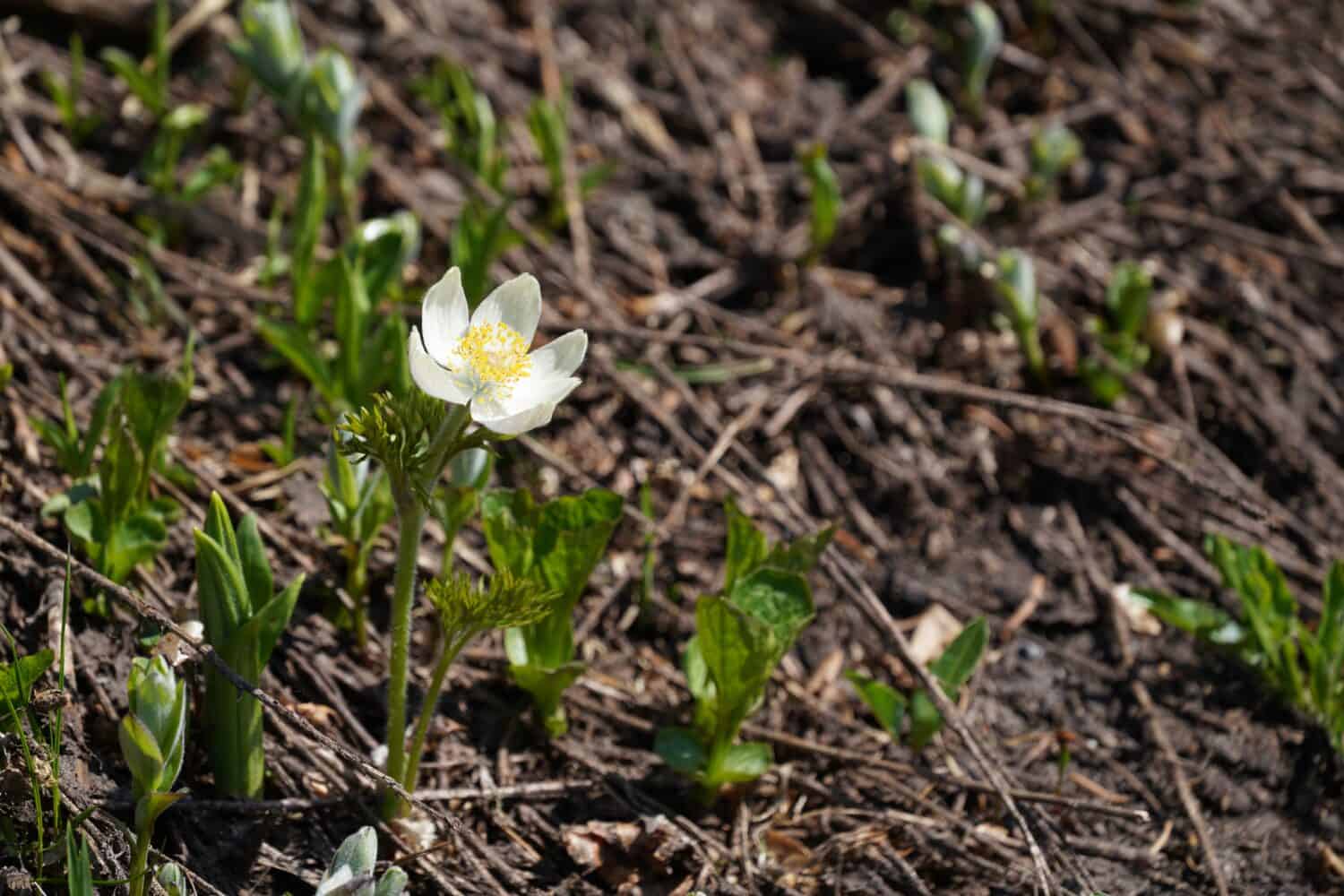
A perennial, the western springbeauty is a gorgeous flower to plant in Southern California.
©Doikanoy/Shutterstock.com
The western springbeauty is a captivating tuberous perennial. It has a short stem with a pair of plump, lance-shaped leaves and presents clusters of 3 to 20 petite, bowl-shaped flowers that are either white or pink in color.
From mid-spring to mid-summer, depending on elevation, these flowers bloom, each showcasing yellow spots near the base of each petal, five white stamens with pink anthers, and a white stigma.
This plant thrives in sandy or loamy soils that are moist and acidic, and it prefers full sun exposure. The western springbeauty doesn’t have significant issues with pests or diseases.
Sow the seeds as soon as they mature, and move the plants outdoors in late spring or early summer after the risk of frost has passed.
13. California Aster (Corethrogyne filaginifolia)

A flowering shrub, the California aster boasts lavender or white flowers.
©Jared Quentin/Shutterstock.com
The California aster is a top choice for Southern California gardens! This rapidly growing plant swiftly provides ground cover. As an evergreen perennial, it forms a splendid cushion of silvery leaves that are softly fuzzy and range in shape from linear to oval.
In the summer through early winter, each stem produces many small flower heads, about an inch across, towards their ends. Each blossom exhibits an outer circle of lavender or white ray flowers.
This plant is easy to grow in clay-based or sandy, well-drained soils under partial shade or full sun.
You can plant California aster throughout the year. However, the ideal conditions for planting occur in the spring when the soil is moist and the temperatures are mild.
14. California Poppy (Eschscholzia californica)

The California poppy has beautiful golden flowers.
©Megs Lang/Shutterstock.com
One of the best flowers to plant in Southern California is none other than the California poppy. With their swift blooming nature and easy cultivation, they’re sure to captivate you with their impressive mounds of finely cut, blue-green feathery leaves, topped with a wealth of silky golden flowers. You can enjoy their radiant display for weeks from spring to mid-fall or from fall through winter in areas with a mild climate.
These poppies thrive in full sun exposure, within sandy soils ranging from poor to average quality, provided they’re well-drained. They are also resistant to heat and drought and can handle coastal exposure as well.
When it comes to sowing, plant the seeds just below the surface (about 1/16-inch deep) during the fall or early spring.
15. Common Sunflower (Helianthus annuus)
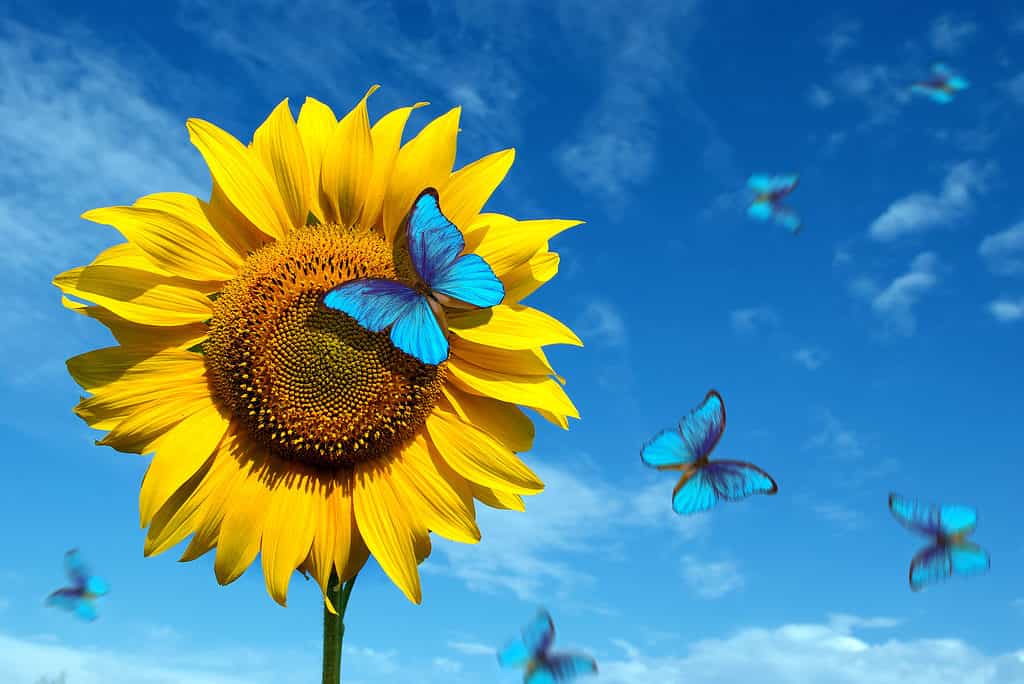
One of the best flowers to plant in Southern California is the gorgeous common sunflower.
©KRIACHKO OLEKSII/Shutterstock.com
The common sunflower could be an ideal flower to plant in your Southern California garden. This fast-growing annual plant boasts broad, oval to heart-shaped leaves with a rough and hairy texture. During the summer, it impresses with its large, radiant flowers, reaching up to 12 inches in diameter. The blooms, boasting bright yellow petals and a rich, dark chocolate center, stand tall on stiff upright stalks. Notably, the blooms follow the sun’s path from dawn to dusk, hence the flower’s name.
These eye-catching blooms make fantastic cut flowers, and they significantly enhance the visual appeal of beds and borders.
The common sunflower thrives in full sun and prefers moderately fertile, moist, humus-rich, alkaline to neutral, well-drained soils. But this flower isn’t overly picky about soil quality and can grow in poor soils as well.
The optimal time for planting sunflowers seeds is generally from the middle of April to the end of May, in late spring.
Summary of Best Flowers to Plant in Southern California
| Number | Flower | Sun Exposure |
|---|---|---|
| 1 | Common Foxglove | Part shade to full sun |
| 2 | Coulter’s Snapdragon | Part shade to full sun |
| 3 | Winter Jasmine | Full sun to part shade |
| 4 | California Goldfields | Full sun to part shade |
| 5 | Yerba Mansa | Full sun |
| 6 | Sea Thrift | Full sun |
| 7 | Narrow Leaf Milkweed | Full sun |
| 8 | African Marigold | Full sun |
| 9 | Elegant Cluster-Lily | Full sun |
| 10 | Cobwebby Thistle | Full sun |
| 11 | Wiinecup Clarkia | Full sun |
| 12 | Western Spring Beauty | Full sun |
| 13 | California Aster | Full sun or part shade |
| 14 | California Poppy | Full sun |
| 15 | Common Sunflower | Full sun |
The photo featured at the top of this post is © Sundry Photography/Shutterstock.com
Thank you for reading! Have some feedback for us? Contact the AZ Animals editorial team.







